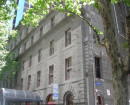STOCK SELLING RING
Saleyard Road,CASTERTON, Glenelg Shire
-
Add to tour
You must log in to do that.
-
Share
-
Shortlist place
You must log in to do that.
- Download report


Statement of Significance
The Casterton Stock Selling Ring Building is located in the municipal sale yards off Saleyards Road about one kilometre south of the town centre on the floodplain of the Wannon River. It is surrounded by extensive newer fenced yards. The building probably dates from the early 1920s when the new municipal sale yards were opened. There had been a steadily increasing but frustrated demand for better, larger, publicly owned yards away from the town centre. Typically, the regular stock sales became an important social event when sellers and buyers mix with their agents. The building is notable for its octagonal plan and traditional form with its suggestion of mediaeval vernacular building types reinforced by its sturdy construction and detailing in local timbers. The central (internal) octagonal ring is surrounded by a fence of timber planks 1.2m high subsequently increased by steel rails to prevent animals escaping. Rough timber benches in tiers surround the internal ring on five sides, the other three remaining open. An auctioneer's box is positioned in the middle of the three open sides, while gates on either side provide access and egress to the yards. Importantly, a monitor roof supported on posts at each corner of the ring and with glazing on all of its eight sides provides excellent light for the selling of stock. Stock agents could contact sellers and buyers by means of a phone in the surviving red phone box. The building was only used for selling bulls or pedigree cows and, sometimes, for selling horses. The building was almost certainly designed by the long serving Shire Engineer, Claude Alexander Mickle and built by local contractors, John and Ernest Spurrell. Although apparently once common, this may be one of the few surviving examples of such a stock selling ring. It can be contrasted with the Wimmera Stock Bazaar which is rectangular in plan, later in construction, grander in style and used more for the sale of horses. The building retains a very high degree of integrity and is in good condition. It is no longer used for selling stock.
How is it significant?
The Casterton Stock Selling Ring is of historical and architectural significance to the State of Victoria.
Why is it significant?
The Casterton Stock Selling Ring is of historical significance for its association with the sale of animals in the further Western District, especially reflecting the increasing market of the selection and closer settlement periods and the post-War prosperity of the 1920s. The selling ring demonstrates the importance of Casterton as a source of quality breeding stock for the pastoral industry.
The Casterton Stock Selling Ring is of architectural significance for its traditional, possibly mediaeval octagonal form, for its monitor roof to provide good lighting and its vernacular construction and detailing.
It is significant as an excellent representative example of a building type once common in the State of Victoria and as a comparison to larger, grander stock bazaars which adopted a rectangular or basilica form.
-
-
STOCK SELLING RING - Usage/Former Usage
Continues as a selling ring and salesyard
STOCK SELLING RING - Physical Description 1
The Stock Selling Ring building at the Casterton sale yards appears to adopt a traditional, even mediaeval vernacular form. It is a large timber framed structure, octagonal in plan with the selling ring at the centre and tiered timber benches on five sides. Each side measures 6.7m wide and 3.3m high and the total width of the building is 16.8m. The seating extends out 3.6m from the ring. A two-tiered roof rises to form an octagonal monitor roof with six paned, hopper sashes on all sides. This provides excellent light for selling cattle. The roofs are corrugated galvanised iron with the mark "Orb Galvanised Tinned". The walls of the five closed sides are also clad externally with the same iron and lined with standard hardwood timber boards. The selling ring is panelled on the inside with upright hardwood timber planks to a height of 1.2m. Above the panelling, two rows of galvanised steel piping have been fixed at a later stage. The ring is open on all sides, with an auctioneer's box in the centre of the front of the octagon. Gates on either side of the box provide access and egress from the yards beyond for the animals being sold. The animals entered on the auctioneer's left and exited on the right. The spectators' door is directly opposite the auctioneer's box.
The upright timbers which support the roof at each corner of the ring are square red gum posts with stringybark rafters and battens. The posts of the outside yards are also red gum and the rails are stringybark or other local hardwood timbers.
A disused telephone box is located near the front of the ring, used by buyers, sellers and stock agents to report sales results. There is a row of Cupressus macrocarpa (Monterey Cypress) trees north of the building, which appears to date from the time of construction, were planted to stop dust blowing into the township.
The building retains a very high degree of integrity and, apart from the broken windows in the monitor roof, it is in good condition.STOCK SELLING RING - Physical Conditions
Good condition
STOCK SELLING RING - Historical Australian Themes
3.5: Developing primary production
3.5.1: Grazing stock
3.5.2: Breeding animals
3.5.3: Developing agricultural industries
3.9: Farming for commercial profit
5.8: Working on the land
7.6.6: Providing services and welfareHeritage Study and Grading
Glenelg - Glenelg Shire Heritage Study Part One
Author: Carlotta Kellaway, David Rhodes Mandy Jean
Year: 2002
Grading:Glenelg - Glenelg Heritage Study Stage Two (a)
Author: Heritage Matters
Year: 2006
Grading:
-
-
-
-
-
CASTERTON RAILWAY STATION
 Victorian Heritage Register H1663
Victorian Heritage Register H1663 -
TOWN HALL
 Southern Grampians Shire
Southern Grampians Shire -
FLEUR-DE-LYS MARKER
 Glenelg Shire
Glenelg Shire
-
-








